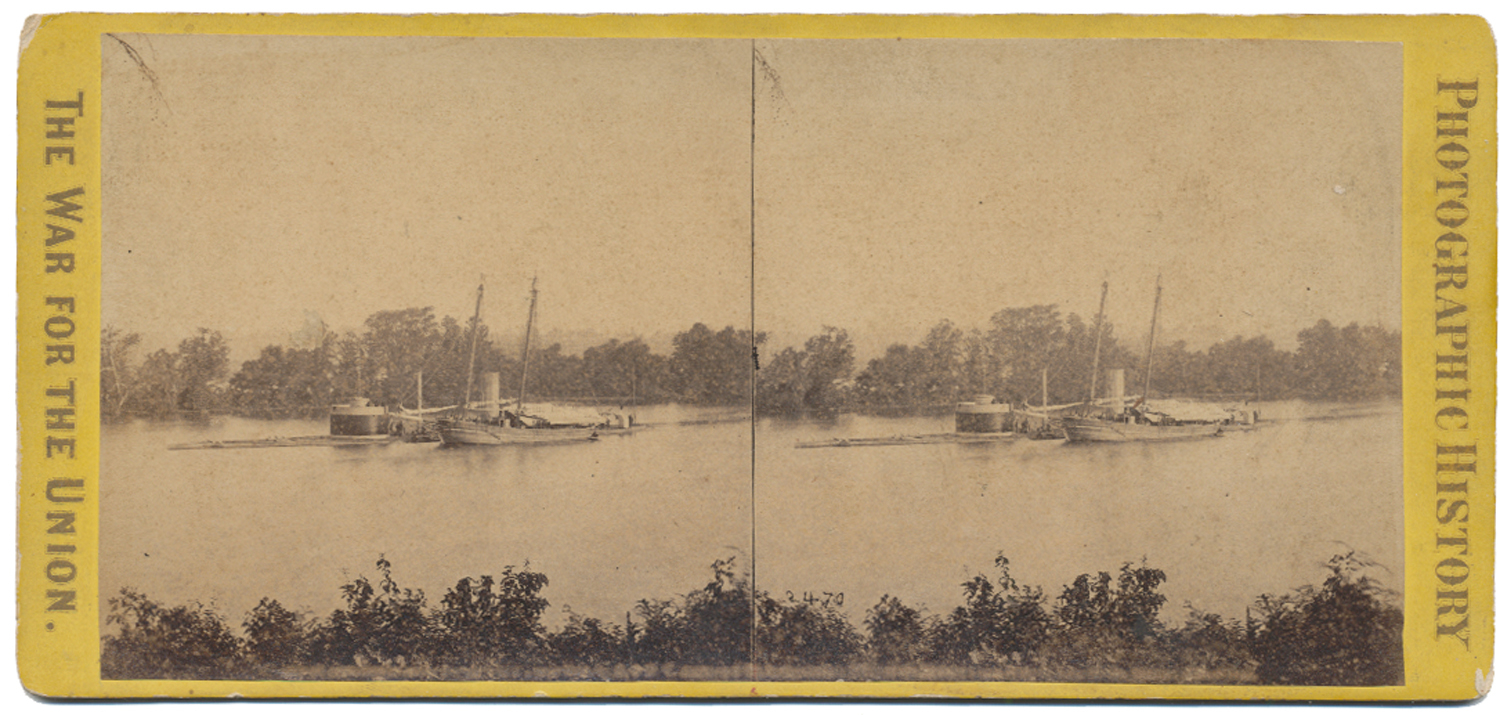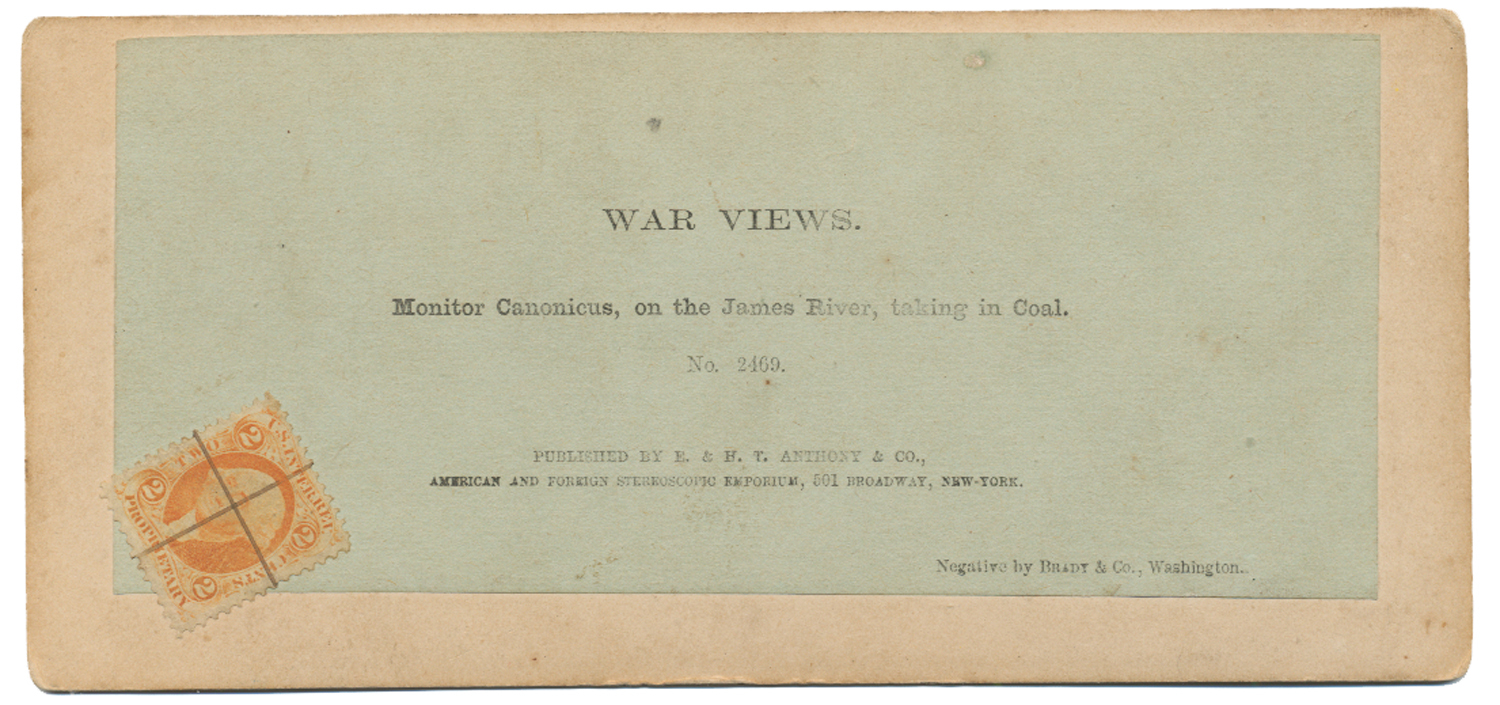site search
online catalog
STEREO CARD VIEW OF THE MONITOR USS CANONICUS IN THE JAMES RIVER

Hover to zoom


$50.00 SOLD
Originally $65.00
Quantity Available: None
Item Code: 490-2377
Stereo card has a yellow mount and is titled on the edges “PHOTOGRAPHIC HISTORY” and “THE WAR FOR THE UNION.”
Reverse has a blue label with a printed caption that reads “WAR VIEWS” and “MONITOR CANONICUS, ON THE JAMES RIVER, TAKING ON COAL NO. 2469.” Label also has a canceled 2 cent tax stamp attached.
Image shows a coal barge standing alongside the USS CANONICUS at midstream of the James River.
View is clear with excellent contrast.
USS CANONICUS was a single-turret monitor built for the United States Navy and was the lead ship of her class. She was armed with two 15-inch Dahlgren guns in her turret.
USS CANONICUS sailed from Boston on 22 April 1864 and arrived at Newport News, Virginia on 3 May for service with the James River Flotilla. She reached the mouth of the Appomattox River by 5 May. By 22 May, the ship was deployed with her sisters SAUGUS and TECUMSEH on the James River where they protected the transports of Major General Benjamin Butler's Army of the James, supplying the army as it operated on the south bank of the river during the Bermuda Hundred Campaign. On 21 June, Commander Craven of the TECUMSEH spotted a line of breastworks that the Confederates were building at Howlett's Farm and his ship opened fire at the workers. The Confederates replied with a battery of four guns near the breastworks and SAUGUS and CANONICUS joined in the bombardment. A half-hour later, Confederate ships near Dutch Gap joined in, but their fire was ineffective because they were firing blindly at the Union monitors. During the engagement, CANONICUS fired forty 15-inch shells and was hit twice by Confederate shells. One shell pierced the upper part of the funnel and the other struck the deck and ricocheted into the turret; no one was wounded or killed during the engagement. The ship dueled with Howlett's Battery on 5 and 6 December, firing 46 shells without being hit in return. The only damage sustained was from the muzzle blast of the right gun that forced the armor at the gun port out about one inch and broke a number of bolts.
Reassigned to the North Atlantic Blockading Squadron, the monitor arrived at Beaufort, North Carolina, accompanied by the side-wheel gunboat RHODE ISLAND, on 15 December 1864, and took part in the attacks on Fort Fisher, North Carolina. In the first engagement on 24–25 December, CANONICUS anchored at ranges from 900–1,200 yards and fired 144 rounds, Lieutenant Commander George Belknap claiming to have dismounted two Confederate guns. The ship was hit four times, but suffered no casualties and no significant damage. On 13–15 January 1865, during the second attack, CANONICUS fired 279 shells at the fort, most on the first day, again claiming to have dismounted two guns. She was hit at least 38 times in return but was only lightly damaged, and three crewmen were wounded. The ship's flag was twice shot away and replaced each time by Quartermaster Daniel D. Stevens. Stevens was later awarded the Medal of Honor for his actions.
On 17 January 1865, CANONICUS, towed by the steam sloop-of-war TUSCARORA, was ordered to join the South Atlantic Blockading Squadron and arrived at Charleston on 19 January. The following month, CANONICUS and the monitors MONADNOCK and CATSKILL captured a blockade runner that had run aground on Sullivan's Island on the night of 18 February. The ship, towed by the steamer FAHKEE, together with MONADNOCK and other ships steamed to Havana, Cuba in late May in search of the CSS STONEWALL and arrived there after the ship had been turned over to the Spanish authorities by her captain. The two monitors were the first American ironclads to arrive at a foreign port and returned to the United States on 6 June.
CANONICUS arrived at the Philadelphia Navy Yard on 25 June 1869 and was decommissioned five days later. The ship was renamed SCYLLA on 15 June 1869, but resumed her former name on 10 August 1869. She was recommissioned on 22 January 1872, and cruised the coastal waters of the Atlantic and Gulf of Mexico whenever she was in commission. CANONICUS was finally decommissioned in 1877 at Pensacola, Florida. The elderly monitor was towed to Hampton Roads, Virginia, in mid-1907 as an exhibit during the Jamestown Exposition as the last survivor of the Civil War monitors. CANONICUS was sold for scrap on 19 February 1908. [ad] [ph:L]
~~~~~~~~~~~~~~~~~~~~~~~~~~~~~~~~~~~
THIS ITEM, AS WITH ALL OTHER ITEMS AVAILABLE ON OUR WEB SITE,
MAY BE PURCHASED THROUGH OUR LAYAWAY PROGRAM.
CLICK HERE FOR OUR POLICIES AND TERMS.
THANK YOU!
Inquire About STEREO CARD VIEW OF THE MONITOR USS CANONICUS IN THE JAMES RIVER
Most Popular
Historical Firearms Stolen From The National Civil War Museum In Harrisburg, Pa »
Theft From Gravesite Of Gen. John Reynolds »
Selection Of Unframed Prints By Don Troiani »
Fine Condition Brass Infantry Bugle Insignia »
Large English Bowie Knife With Sheath 1870’S – 1880’S »
Imported (Clauberg) Us Model 1860 Light Cavalry Officer's Saber »
featured item
EXCELLENT CONDITION EARLY MARINE MAMALUKE WITH IVORY GRIP AND ENGRAVED SCABBARD
Manufactured: U.S. Maker: Unmarked Year: C1820-25 Model: Mamaluke Size: 29.25 inch blade 1.30 in. wide Condition: Excellent+ Sharply curved, single edged, blue and gold engraved blade decorated with ships mast, Indian with headdress, arms,… (870-72). Learn More »


